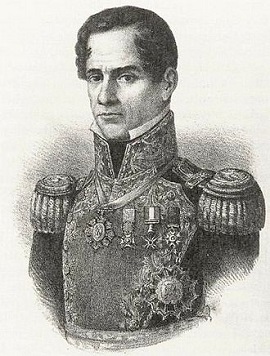On this date in 1867, the Mexican general and onetime president Antonio Lopez de Santa Anna avoided execution at his court-martial.
 Best recognized north of the Rio Grande for overrunning the Alamo, Santa Anna actually enjoyed an amazing career with a near half-century as Mexico’s definitive caudillo.
Best recognized north of the Rio Grande for overrunning the Alamo, Santa Anna actually enjoyed an amazing career with a near half-century as Mexico’s definitive caudillo.
Antonio López de Santa Anna joined the military he would come to personify as a 16-year-old cadet in 1810 … except it was the Spanish colonial army, where he had hands-on training in the cold counterinsurgency tactics he would subsequently apply in his maturity.
Within barely a decade, the ambitious young officer was advanced to general — the last step by dint of his timely adherence to the incoming emperor of now-independent Mexico, Agustin de Iturbide.
Iturbide was destined for a firing squad, but Santa Anna had a better knack for tacking with his new country’s political gales — turning against his recent patron just in time to help depose the guy.
Santa Anna’s P.T. Barnum*-quality panache for shameless self-promotion — at one pont he repelled Spain’s last attempted reconquista and pronounced himself the “Napoleon of the West” — soon self-promoted himself right to the presidency. From 1833 to 1855, he held the office during 11 distinct stints.
His dictatorial exercise of power and abundant graft aroused resistance from more than just Texan Anglos, so he was often engaged in suppressing internal rebellions, and occasionally in being chased by them into exile. His last turn at president was aborted in 1855 by liberal reformers. Santa Anna fled to Cuba.
Considering the mad twists of fortune in his long career, it’s a miracle that none of his enemies ever actually executed Santa Anna. He was: both adoit and lucky to avoid purging during the tumultuous 1820s; captured by rebelling Texans, who preferred to avenge Alamo by forcing him to treaty terms; handed over to the U.S. government, which eventually sent him back to Mexico; captured again by rebelling Indians in Veracruz who sold him to the Mexican government which sent him to exile; and, tried by the liberals who finally toppled him, but in absentia since he had escaped once more. He had more lives than a cat; small wonder that here in his sixties and seventies he still wasn’t done plotting.
A full decade out of power, Santa Anna spent 1866-1867 in Staten Island, New York,** until the fall of Mexico’s French-backed Emperor Maximilian induced him once more — at the age of 73 — to sail for home with one last summons to his banner. Instead he was captured in a position that must have looked like curtains for sure.
The New York Times actually reported on July 5, 1867 that Santa Anna had been summarily executed; in fact, the restored liberal government of Benito Juarez clapped the nettlesome general in prison and subjected him to a court martial that ran Oct. 7-10. Juarez allegedly expected the old snake to be convicted of treason and finally executed, but like the Times, Juarez too was frustrated: the commission sentenced Santa Anna to exile and he was carried away to Havana once again.
It proved to be a waking death: cheated of the glory of a firing squad, the old general was pitiably forgotten.
“His schemes” — for still he schemed — “became increasingly the ravings of an old, deluded, sick man,” writes Robert Scheina in Santa Anna: A Curse Upon Mexico.
Permitted with Juarez’s death in 1874 to return to Mexico, Santa Anna now fought only for a pension. (He lost that fight.) So long his country’s first man, he “became increasingly depressed which was only relieved by his increasing senility. Santa Anna was suffering the worst possible punishment — obscurity and irrelevancy.” He died penniless of diarrhea in 1876.
* Santa Anna eventually came to hobble about on a cork leg, courtesy of a war wound. The leg was captured during the Mexican-American War, and Barnum put the artificial limb on exhibit.
That limb has never been returned to its native soil: Santa Anna’s prosthesis remains available to the Yankee gawker at the Illinois State Military Museum in Springfield.
** Santa Anna’s legacy in the United States (apart from that Alamo unpleasantness) was the importation of chicle, which the general liked to chew. Santa Anna’s American secretary, Thomas Adams, used it to create the chewing gum marketed as chiclets.
On this day..
- 1614: Magdalena Weixler, "my innocence will come to light" - 2020
- 1983: Waldemar Krakos, Dekalog inspiration - 2019
- 1796: Claude Javogues - 2018
- 1989: Jimmy Chua and his Pudu Prison siege accomplices - 2017
- 1783: Jacques Francois Paschal, rapist monk - 2016
- 1932: Lee Bong-chang, would-be Hirohito assassin - 2014
- Corpses Strewn: The Streltsy - 2013
- 1698: The Streltsy executions begin - 2013
- 1987: Eshan Nayeck, the last executed in Mauritius - 2012
- 1707: Johann Patkul, schemer - 2011
- 1800: Prosser's Gabriel, slave rebel - 2010
- 1923: Susan Newell, the last woman hanged in Scotland - 2009
- 1911: Several revolutionaries on Double Ten Day - 2008

Santa Anna vowed to recapture the southwestern United States. I think it’s been scrubbed from all history books but the Mexicans know it.
It’s called “Reconquista”
Where is information on the Reconquista?